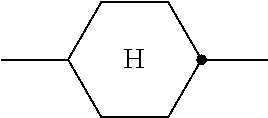Polymerisable compounds and the use thereof in liquid-crystal displays
a technology of liquid crystal display and polymerisable compounds, which is applied in the field of polymerisable compounds and the use thereof in liquid crystal display, can solve the problems of reducing the transparency of light, the disadvantage of strong viewing angle dependence of contrast of tn lcds, and the lengthening of response times, so as to facilitate a quick and complete uv-photopolymerisation reaction and reduce image sticking and odf mura in the display. , the effect o
- Summary
- Abstract
- Description
- Claims
- Application Information
AI Technical Summary
Benefits of technology
Problems solved by technology
Method used
Image
Examples
example 1
able Compounds
[0538]Polymerisable compound (or “RM”) 1 is prepared as follows
[0539]1.4: A suspension of sodium hydride (5.4 g, 60% in mineral oil, 135.6 mmol) was added to a stirred solution of benzyl alcohol 1.3 (20.0 g, 113.0 mmol) in THF (20 mL) at 0° C. The resulting mixture was stirred for 10 min at the same temperature before it was treated with methyl iodide (8.7 mL, 135.6 mmol). The reaction mixture was stirred for 4 hours at ambient temperature, carefully quenched with water and extracted with ethyl acetate. Aqueous phase was separated and extracted with ethyl acetate (2 times). The combined organic phase was washed with sat. NaCl solution, dried over Na2SO4, filtered and concentrated in vacuo. The residue was purified with flash chromatography (heptane) to give 1.4 as a colorless oil. (21.0 g, 97%; GC: 99.9%).
[0540]1.6: Hydrazine hydrate (0.2 mL, 80%, 0.004 mol) was added to a stirred solution of sodium metaborate tetrahydrate (43.3 g, 0.314 mol) and PdCl2[P(cy)3]2 (3.1 g,...
example 2
able Mixtures
[0547]The nematic LC host mixture N1 is formulated as follows:
CCH-501 9.00%cl.p.70.0° C.CCH-3514.00%Δn 0.0825PCH-53 8.00%Δε−3.5CY-3-O414.00%ε∥ 3.5CY-5-O413.00%K3 / K1 1.00CCY-2-1 9.00%γ1 141 mPa sCCY-3-1 9.00%V0 2.10 VCCY-3-O2 8.00%CCY-5-O2 8.00%CPY-2-O2 8.00%
[0548]The nematic LC host mixture N2 is formulated as follows:
CY-3-O218.00%cl.p.+74.5° C.CPY-2-O210.00%Δn 0.1021CPY-3-O210.00%Δε−3.1CCY-3-O2 9.00%ε∥ 3.5CCY-4-O2 4.00%K3 / K1 1.16PYP-2-3 9.00%γ1 86 m Pa sCC-3-V40.00%V0 2.29 V
[0549]The nematic LC host mixture N3 is formulated as follows:
CC-3-V1 9.00%cl.p.CCH-2314.00%ΔnCCH-34 6.00%ΔεCCH-35 6.00%ε∥CCP-3-1 7.00%K3 / K1CCY-3-O1 5.00%γ1CCY-3-O210.00%V0CPY-3-O212.00%CY-3-O2 9.50%PP-1-2V1 8.50%PY-3-O212.00%PY-4-O2 1.00%
[0550]Polymerisable mixtures P11, P21 and P31 according to the present invention are prepared by adding polymerisable compound RM1 of Example 1 to nematic LC host mixture N1, N2 or N3, respectively.
[0551]For comparison purpose, polymerisable mixtures C...
example 3
les
[0553]The individual polymerisable mixtures are filled into PSA test cells, the RM is polymerised under application of a voltage, and several properties like residual RM content, VHR under UV stress, tilt angle generation and tilt angle stability are measured.
Residual RM Measurement
[0554]The polymerisation speed is measured by determining the residual content of residual, unpolymerised RM (in % by weight) in the mixture after UV exposure with a given intensity and lamp spectrum after a given UV exposure time. The smaller the residual RM content after a given time interval, the faster the polymerization,
[0555]For this purpose the polymerisable mixtures are filled into electrooptic test cells made of soda lime glass coated with an approximately 200 nm thick layer of ITO and a 30 nm layer of VA-polyimide from Varitronix with a cell gap of 6-7 μm
[0556]The test cells are illuminated by a MH-lamp (UV-Cube 2000) using a 320 nm long pass filter (N-WG320) and a light intensity of 100 mW / c...
PUM
| Property | Measurement | Unit |
|---|---|---|
| tilt angle | aaaaa | aaaaa |
| tilt angle | aaaaa | aaaaa |
| wavelengths | aaaaa | aaaaa |
Abstract
Description
Claims
Application Information
 Login to View More
Login to View More - R&D
- Intellectual Property
- Life Sciences
- Materials
- Tech Scout
- Unparalleled Data Quality
- Higher Quality Content
- 60% Fewer Hallucinations
Browse by: Latest US Patents, China's latest patents, Technical Efficacy Thesaurus, Application Domain, Technology Topic, Popular Technical Reports.
© 2025 PatSnap. All rights reserved.Legal|Privacy policy|Modern Slavery Act Transparency Statement|Sitemap|About US| Contact US: help@patsnap.com



